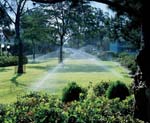Whether you desire a lush green tropical yard or a low maintenance drought tolerant desert landscape, an efficient well-functioning sprinkler system is an absolute necessity.In today’s rapidly changing world of population growth and diminishing resources we can no longer afford to foolishly waste water. With advances of today’s hydro-technology we can design sprinkler systems with water saving features that provide optimum water savings which translates to immediate cost savings for both the homeowner and commercial user.
Most commercial and residential irrigation systems are “in ground” systems, which means that everything is buried in the ground. With the pipes, sprinklers, emitters (drippers), and some irrigation valves being hidden, it makes for a cleaner, more presentable landscape without garden hoses or other items having to be moved around manually.
Controllers, zones, and valves
Most irrigation systems are divided into zones. A zone is a single irrigation valve and one or a group of drippers or sprinklers that are connected by pipes or tubes. Irrigation systems are divided into zones because there is usually not enough pressure and available flow to run sprinklers for an entire yard or sports field at once. Each zone has a solenoid valve on it that is controlled via wire by an irrigation controller. The irrigation controller is an electrical device that signals a zone to turn on at a specific time and keeps it on for a specified amount of time. “Smart Controller” is a recent term used to describe a controller that is capable of adjusting the watering time by itself in response to current environmental conditions. The smart controller determines current conditions by means of historic weather data for the local area, a soil moisture sensors (water potential or water content), rain sensor, or in more sophisticated systems satellite feed weather station, or a combination of these.
Emitters and sprinklers
When a zone comes on, the water flows through the lateral lines and ultimately ends up at the irrigation emitter (drip) or sprinkler heads. Many sprinklers have pipe thread inlets on the bottom of them which allows a fitting and the pipe to be attached to them. The sprinklers are usually installed with the top of the head flush with the ground surface. When the water is pressurized, the head will pop up out of the ground and water the desired area until the valve closes and shuts off that zone. Once there is no more water pressure in the lateral line, the sprinkler head will retract back into the ground. Emitters are generally laid on the soil surface or buried a few inches to reduce evaporation losses.
 When installing a sprinkler system, there are many factors to think about. What kind of sprinkler heads should I use? Will I have matched precipitation rates? How elaborate a sprinkler controller do I need? What size sprinkler valves? Do I need a back-flow device? What kind of tubing or pipes should I use? It can be a real challenge and a really big job for an inexperienced weekend warrior to handle.
When installing a sprinkler system, there are many factors to think about. What kind of sprinkler heads should I use? Will I have matched precipitation rates? How elaborate a sprinkler controller do I need? What size sprinkler valves? Do I need a back-flow device? What kind of tubing or pipes should I use? It can be a real challenge and a really big job for an inexperienced weekend warrior to handle.
Wouldn’t you rather let a sprinkler professional install your lawn sprinkler system? A-Plus Sprinkler and Landscape can handle any sprinkler system installation or repair job necessary. We have been installing sprinklers since 1996, and have loved every minute of it.
Do you already have an existing system installed? We can automate, update, convert to drip irrigation or repair any existing system. We guarantee all sprinkler repairs for one year and new installations for two years.
We service both residential and commercial customers in the Inland Empire, Southern California. Cities include: Colton, Fontana, Grand Terrace, Highland, Lake Arrowhead, Crestline, Loma Linda, Redlands, Rialto, San Bernardino, Alta Loma, Rancho Cucamonga and Yucaipa.
Call us today at (800) 340-5022 for a free estimate and consultation.


